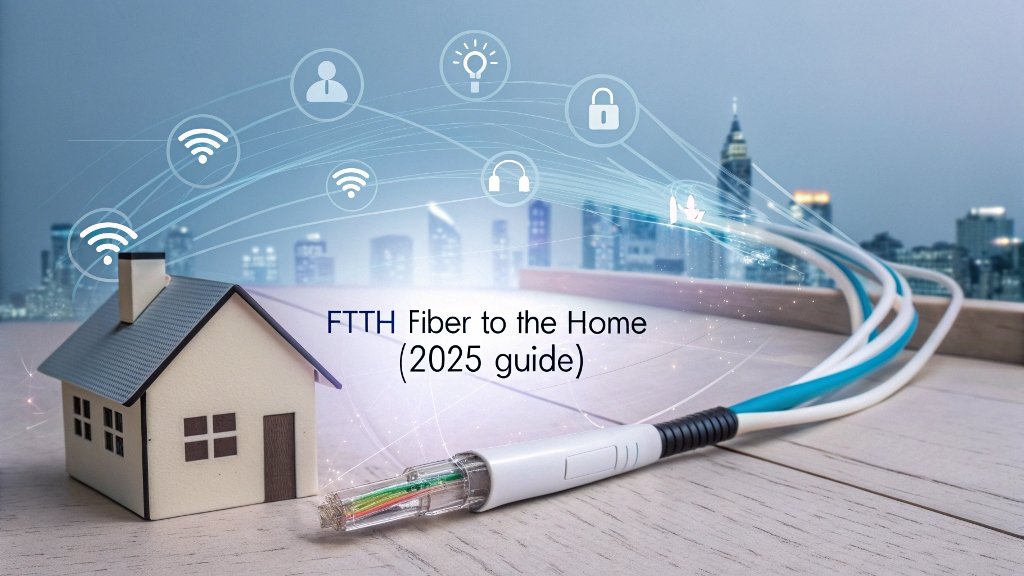Introduction: Why FTTH Is Revolutionizing Internet Connectivity
Imagine downloading a full HD movie in seconds, streaming 4K videos without buffering, or having zero lag in online gaming. That’s the power of Fiber-to-the-Home (FTTH)—the fastest, most reliable internet technology available today.
But what exactly is FTTH? How does it work? Why should you care?
In this guide, we’ll break down:
✔ What FTTH is (and how it differs from traditional broadband)
✔ How FTTH works (fiber optics vs. copper cables)
✔ Key benefits (speed, reliability, future-proofing)
✔ Installation & setup (what to expect)
✔ FTTH vs. other internet types (DSL, cable, wireless)
By the end, you’ll know whether FTTH is right for you—and how to get it installed.
(Need FTTH equipment? Chat with our experts on WhatsApp!)
1. What is FTTH? (Fiber-to-the-Home Explained)
FTTH (Fiber-to-the-Home) is an internet connection where optical fiber cables run directly to your home, delivering ultra-fast, low-latency internet. Unlike traditional broadband (which uses copper wires), FTTH relies on light signals for data transfer, making it 20x faster than DSL or cable.
How Does FTTH Work?
FTTH networks consist of:
- Optical Line Terminal (OLT) – The central hub managing connections.
- Optical Network Terminal (ONT) – The device in your home that converts fiber signals to usable internet.
- Fiber Optic Cables – Thin glass/plastic wires transmitting data via light pulses.
Here’s a simple breakdown:
- Your ISP sends data as light signals through fiber cables.
- The ONT in your home converts these signals into Ethernet/Wi-Fi.
- You get gigabit speeds (up to 1Gbps or more) with near-zero latency.
💡 Example:
If regular broadband is like drinking through a straw, FTTH is like opening a firehose.
2. Key Benefits of FTTH (Why It’s Better Than Broadband)
| Feature | FTTH | Traditional Broadband |
|---|---|---|
| Speed | 100Mbps–10Gbps | 10–100Mbps |
| Latency | <5ms | 20–100ms |
| Reliability | Unaffected by weather | Signal loss in rain/storms |
| Future-Proof | Supports 8K, VR, IoT | Limited bandwidth |
Why Choose FTTH?
✔ Blazing-fast speeds – Download 1GB files in seconds.
✔ No throttling – Unlike cable, fiber doesn’t slow down during peak hours.
✔ Symmetrical speeds – Upload as fast as you download (great for streaming & work).
✔ Low latency – Perfect for gaming, Zoom calls, and smart homes.
(Want FTTH installed? Get a free consultation on WhatsApp!)
3. FTTH Installation: What to Expect
Worried about setup? Here’s how it works:
Step-by-step FTTH Installation
- ISP Survey – A technician checks feasibility.
- Fiber Cable Routing – Thin cables are run to your home (minimal drilling).
- ONT Setup – A small device is installed (usually near your router).
- Activation – Your ISP configures the connection.
📌 Pro Tip:
- If you’re an ISP or installer, you’ll need OLTs, ONTs, and fiber cables.
- For home users, most ISPs handle everything.
4. FTTH vs. Other Internet Types (Which Is Best?)
| Type | Speed | Latency | Best For |
|---|---|---|---|
| FTTH | 100Mbps–10Gbps | <5ms | Gaming, 4K streaming, smart homes |
| Cable | 50–500Mbps | 20–50ms | General browsing, HD video |
| DSL | 5–50Mbps | 50–100ms | Basic internet (no heavy usage) |
| Wireless | 10–100Mbps | 30–80ms | Rural areas (where fiber isn’t available) |
Winner? FTTH—if available in your area.
5. Is FTTH Right for You? (Case Study)
Scenario:
A small ISP in Rajasthan switched from copper to FTTH and saw:
- 50% fewer complaints (no signal drops).
- 3x faster speeds for customers.
- Higher customer retention (users loved the reliability).
Moral: If you want future-proof internet, FTTH is the way.
Conclusion: Ready to Upgrade to FTTH?
FTTH isn’t just faster internet—it’s smarter internet. With unmatched speed, reliability, and scalability, it’s the best choice for:
✔ Gamers & streamers (no lag, no buffering).
✔ Remote workers (seamless Zoom calls).
✔ Smart homes (supports 50+ devices).
Next Steps:
- Check if FTTH is available in your area.
- Contact your ISP (or message us for equipment).
🚀 Upgrade to FTTH today—surf at the speed of light!

